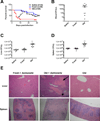Transfusion of stored blood impairs host defenses against Gram-negative pathogens in mice
- PMID: 24840185
- PMCID: PMC4229414
- DOI: 10.1111/trf.12712
Transfusion of stored blood impairs host defenses against Gram-negative pathogens in mice
Abstract
Background: Although human red blood cell (RBC) units may be refrigerator stored for up to 42 days, transfusion of older RBCs acutely delivers a large bolus of iron to mononuclear phagocytes. Similarly, iron dextran circulates in plasma for hours to days and is progressively cleared by mononuclear phagocytes, which return iron to plasma. Finally, malaria infection continuously delivers iron to macrophages by intra- and extravascular hemolysis. Studies suggest that iron administration increases infectious risk.
Study design and methods: To assess the effects of increased iron availability on susceptibility to infection, we infected mice with model Gram-negative intracellular or extracellular pathogens (Salmonella typhimurium or Escherichia coli, respectively), accompanied by RBC transfusion, iron dextran administration, or malarial coinfection.
Results: In our mouse models, transfusion of older RBCs exacerbates infection with both Gram-negative pathogens. Although iron dextran exacerbates E. coli infection to a similar extent as transfusion of corresponding amounts of iron, higher iron doses are required to produce comparable effects with S. typhimurium. Coinfection of mice with Plasmodium yoelii and S. typhimurium produces overwhelming Salmonella sepsis. Finally, treating mice with antibiotics abrogates the enhancing effect on E. coli infection of both older RBC transfusion and iron dextran administration.
Conclusions: Transfusion of older RBCs exacerbates Gram-negative infection to a similar extent as malaria coinfection or iron dextran administration. Appropriate antibiotic therapy abrogates the effect of older RBC transfusions on infection with E. coli. Iron delivery to macrophages may be an underappreciated mechanism mediating, at least some, adverse effects of RBC transfusions.
© 2014 AABB.
Conflict of interest statement
KF is an employee of PerkinElmer. The other authors have disclosed no conflicts of interest.
Figures




References
-
- Sazawal S, Black RE, Ramsan M, et al. Effects of routine prophylactic supplementation with iron and folic acid on admission to hospital and mortality in preschool children in a high malaria transmission setting: community-based, randomised, placebo-controlled trial. Lancet. 2006;367:133–143. - PubMed
-
- Barry DM, Reeve AW. Increased incidence of gram-negative neonatal sepsis with intramuscula iron administration. Pediatrics. 1977;60:908–912. - PubMed
-
- Drakesmith H, Prentice AM. Hepcidin and the iron-infection axis. Science. 2012;338:768–772. - PubMed
-
- Raiten DJ, Namaste S, Brabin B. Considerations for the safe and effective use of iron interventions in areas of malaria burden—executive summary. Int J Vitam Nutr Res. 2011;81:57–71. - PubMed
Publication types
MeSH terms
Substances
Grants and funding
LinkOut - more resources
Full Text Sources
Other Literature Sources
Medical

